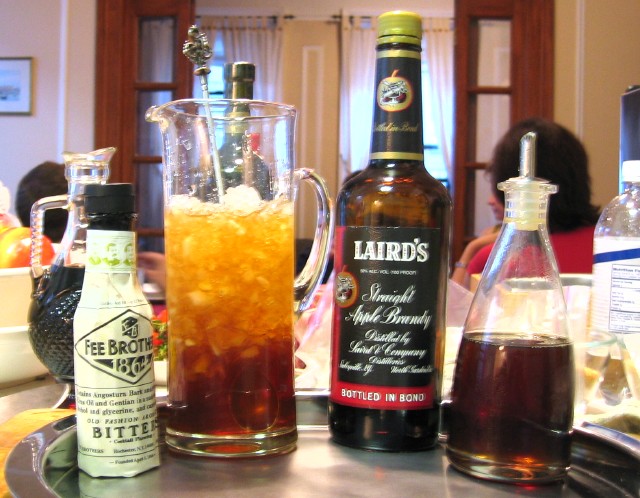 Did you think that the adjective "straight" (as it pertains to spirits) could only be applied to whiskey or that only a whiskey could be bottled in bond? So did I. But I was wrong, so wrong. "Straight" can apply to any spirit type and means that the spirit has been distilled to no more than 160 proof and has not been mixed with any grain neutral spirits. In the case of straight apple brandy, I would imagine that the mash that it's made from would have to be at least 51% apples, but I don't know what else could be in the mash. Pears? Grapes? Grain? (I know: grain sounds revolting, but who knows?) And any spirit can be bottled in bond, provided that it is made at one distillery in one season, aged for at least four years in oak casks, has not had any flavoring or other adulterant added to it, and is bottled under government supervision at 100 proof. So it is thus possible for Laird's to produce Laird's Straight Apple Brandy, Bottled in Bond. The label says that it is bottled at DSP-NJ-1, Laird's Scobeyville, NJ facility. For some reason, it doesn't say where it was distilled, although Laird's website says that all distillation is now done in North Garden, VA.
Did you think that the adjective "straight" (as it pertains to spirits) could only be applied to whiskey or that only a whiskey could be bottled in bond? So did I. But I was wrong, so wrong. "Straight" can apply to any spirit type and means that the spirit has been distilled to no more than 160 proof and has not been mixed with any grain neutral spirits. In the case of straight apple brandy, I would imagine that the mash that it's made from would have to be at least 51% apples, but I don't know what else could be in the mash. Pears? Grapes? Grain? (I know: grain sounds revolting, but who knows?) And any spirit can be bottled in bond, provided that it is made at one distillery in one season, aged for at least four years in oak casks, has not had any flavoring or other adulterant added to it, and is bottled under government supervision at 100 proof. So it is thus possible for Laird's to produce Laird's Straight Apple Brandy, Bottled in Bond. The label says that it is bottled at DSP-NJ-1, Laird's Scobeyville, NJ facility. For some reason, it doesn't say where it was distilled, although Laird's website says that all distillation is now done in North Garden, VA.Applejack has a venerable tradition in the United States, particularly in the Northeast. In colonial times, people would leave barrels of hard cider out during the winter and repeatedly skim off the ice that formed inside. Because alcohol has a much lower freezing point than water, the skimmed ice would be mostly water, which would have the effect of increasing the concentration of alcohol in the liquid that remained. This method of production is called fractional freezing. The problem with it is that ethanol is not the only kind of alcohol in hard cider that is concentrated by fractional freezing. Fermentation of apples (and of grains and other fermentable substances) does not just produce ethanol. It also produces small quantities of methanol and fusel alcohols, which are highly toxic. They're not a problem in hard cider or beer or wine, but they are a problem in a spirit produced by fractional freezing. Nobody with any sense makes spirits this way any more, and it has been thus for more than two hundred years.
The Laird family has been making applejack since 1698. Their first commercial production was in 1780, making them the oldest still-operating American distillery. Up until the 1970s, their applejack was pure apple brandy; but they have since blended it with grain neutral spirits to lighten its flavor and reduce their costs. Their bottling labeled applejack is currently about 35% apple brandy and 65% GNS. They label all the pure apple brandy as apple brandy instead of applejack. The BIB bottling that I tried last night is probably four years old or maybe a bit older. There are also 7.5 year old and 12 year old versions. All of Laird's apple brandies are aged in charred oak barrels, which brings me to my initial impression of the BIB: it's like apple whiskey. I can't claim credit for that phrase, but it is accurate. The barrels give the brandy lots of char and vanilla aromas, just like Bourbon. There's also a distinctive apple juice aroma, but the char and vanilla dominates. On the palate, it's fruit-dominated, sweet, and a little rough. It could use more time in the barrel, but it is pleasant.
Oh, and it is nothing at all like the Calvados that I had a few days ago. I'm eager to try the Laird's 12 YO to see if the age gives it more of a Calvados character. But this is enjoyable enough for what it is. *
* And before Mamacita points it out, yes, I did try this out of a plastic cup while watching fireworks at New Year's; and I didn't like it much then. Of course, drinking anything out of a plastic cup is not perfectly calculated to show it at its best advantage. It was much better last night.


No comments:
Post a Comment